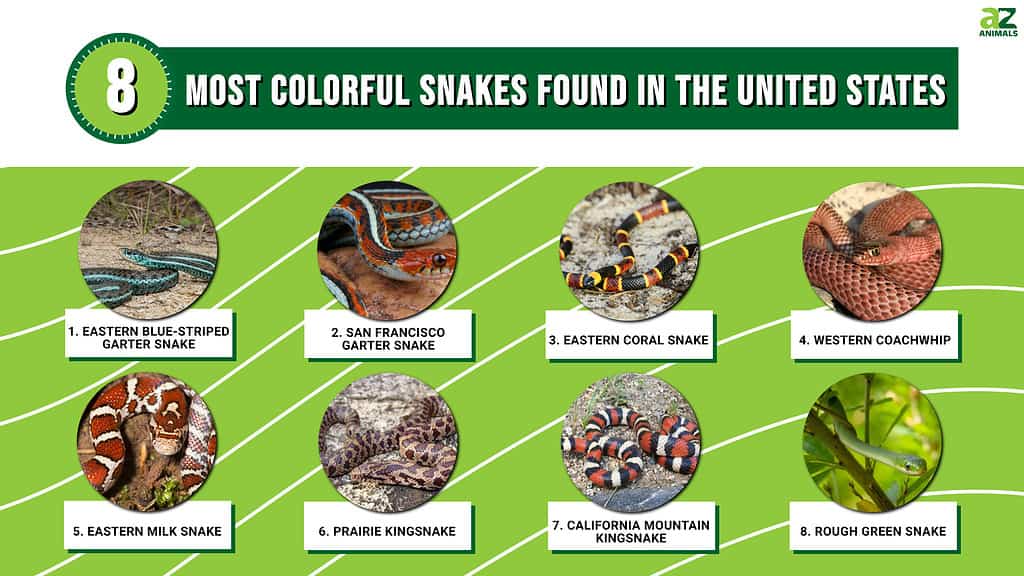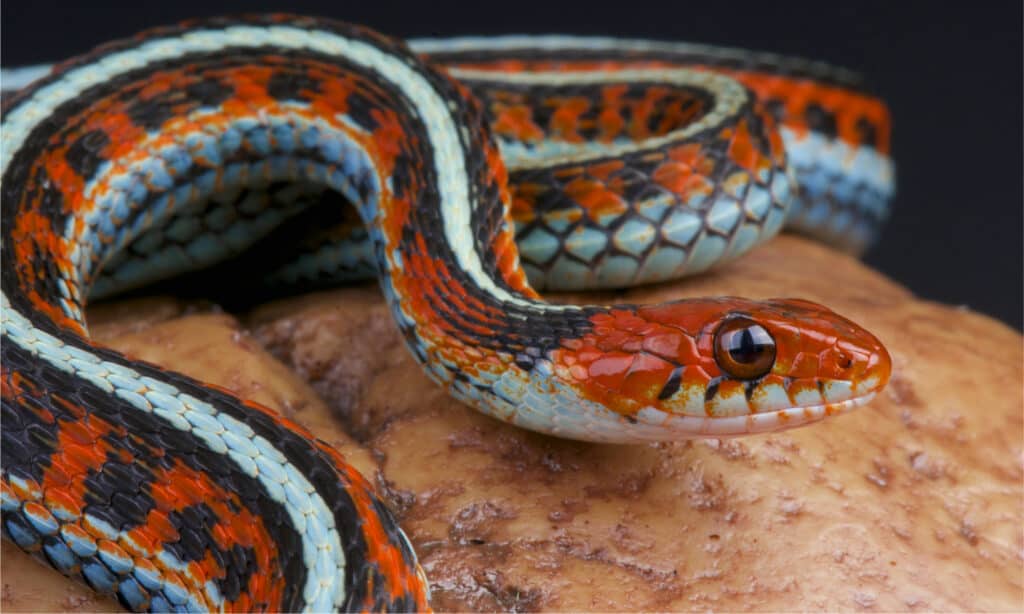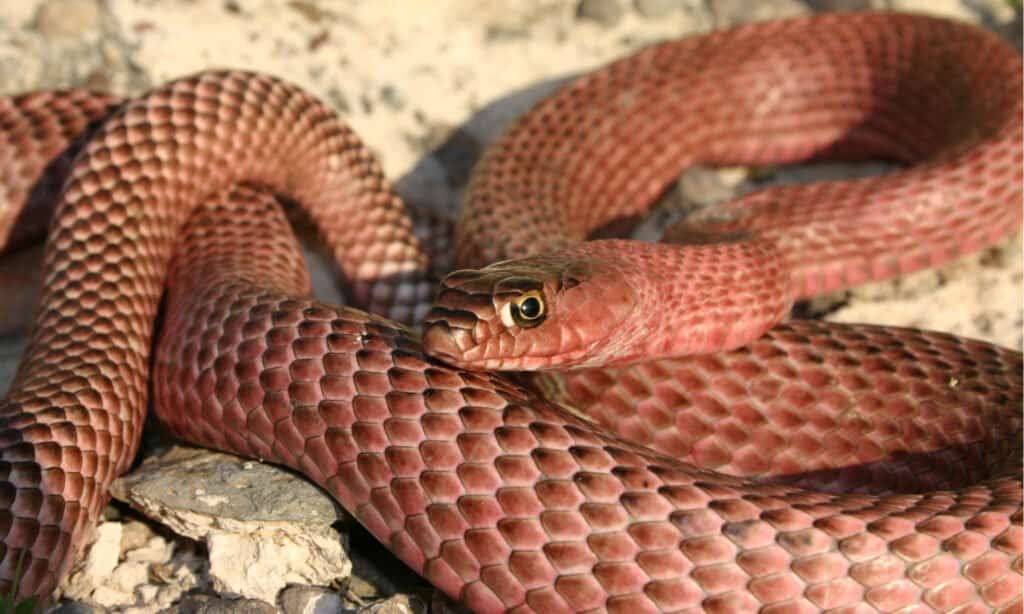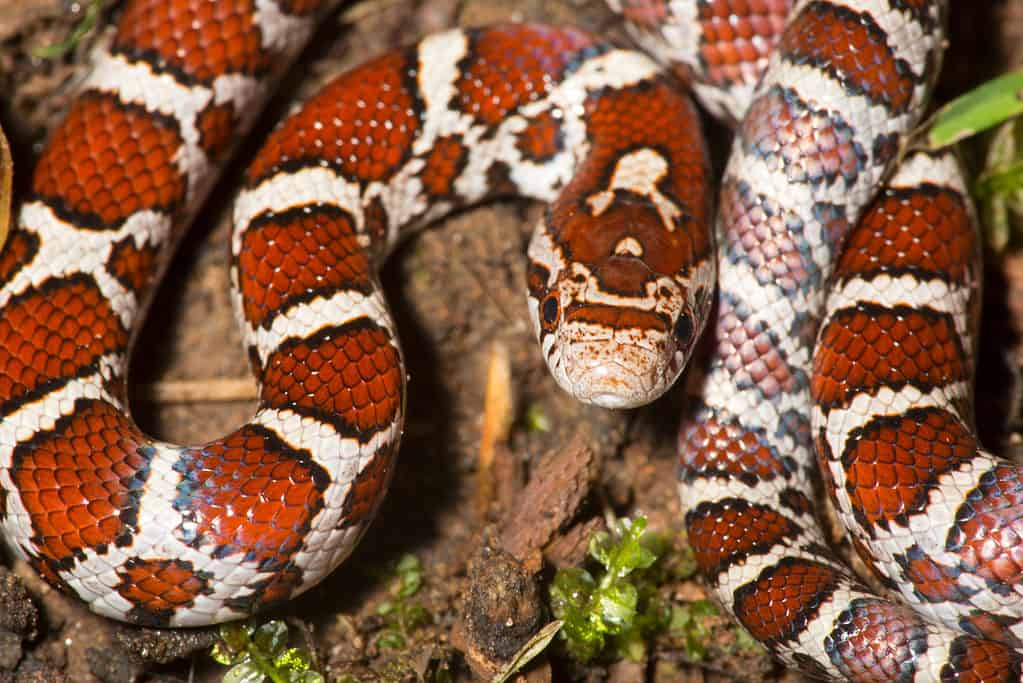Nature has an extraordinary talent for showcasing diversity through its fascinating array of creatures, and snakes are no exception. With their slithering movements and enigmatic presence, snakes have captivated the human imagination for centuries. While many of us associate snakes with a typical earth-toned appearance, the United States is home to an astonishing variety of colorful snakes that seem to have been painted by the hand of a skilled artist.

In this list, we’ll look at the enchanting world of the most colorful snakes in the United States, where nature unfolds a mesmerizing palette of vibrant hues. From the sun-drenched deserts of the Southwest to the lush forests of the Southeast, these reptiles grace their habitats with an awe-inspiring display of colors that rival even the most vibrant flowers.
1. Eastern Blue-Striped Garter Snake
Classification: Thamnophis sirtalis sirtalis

The blue-striped garter snake (pictured) comes in several stunning shades of blue.
©Jay Ondreicka/Shutterstock.com
The Eastern blue-striped garter snake is a fascinating reptile with a distinctive appearance. This snake species typically measures around 16 to 26 inches in length and possesses a slender body. As the name suggests, it showcases a vibrant blue coloration along its sides, which is accentuated by a series of thin, pale yellow, or cream stripes running parallel to the blue stripes. Its dorsal side exhibits a darker hue, often a shade of black or dark green.
Garter snakes are in the wild throughout the eastern regions of North America, including areas such as Maine, Florida, and parts of eastern Canada. They prefer habitats with ample vegetation, such as forests, meadows, marshes, and even suburban gardens. Being excellent swimmers, they are also frequently near bodies of water like ponds, streams, and wetlands.
In terms of diet, the Eastern blue-striped garter snake is carnivorous. It feeds primarily on small prey, including insects, earthworms, frogs, tadpoles, and small fish. It possesses a unique adaptation called “lingual luring,” where it flicks its tongue to mimic a worm, enticing prey to come closer. This specialized feeding behavior helps the snake to capture its prey more effectively.
What makes the Eastern blue-striped garter snake remarkable is its ability to secrete a foul-smelling musk when threatened, deterring potential predators. Just as well, they are known for their gentle disposition and are not considered dangerous to humans. This snake plays a crucial ecological role by controlling populations of pests like rodents and insects.
2. San Francisco Garter Snake
Classification: Thamnophis sirtalis tetrataenia

The San Francisco garter snake (pictured) is an endangered species.
©reptiles4all/Shutterstock.com
The San Francisco garter snake has a striking look that earns it a spot on our list of colorful snakes. This snake’s stunning blend of brilliant red, blue, and black scales gives it a distinctive hue. Its red head disappears into a blue body with black horizontal lines along the length of it. Potential predators are warned by this distinctive color of the animal’s venomous nature. (That’s right; it’s recently been discovered that garter snakes do produce a type of neurotoxic venom!)
The San Francisco garter snake is a rare and geographically limited species that is confined to the San Francisco Bay Area in California. It inhabits certain environments like marshes, wetlands, and grasslands close to bodies of water like ponds and streams. Unfortunately, habitat degradation and human activity have caused a dramatic fall in this snake’s population, making it an endangered species.
The San Francisco garter snake is a carnivorous snake that prefers to eat tiny prey like frogs and fish. Tadpoles, frogs, and tiny fish that live in the wetlands where it lives make up this species’ diet. The snake’s unique jaw shape allows it to swallow food whole, which helps with its effective feeding process.
Unfortunately, being one of the most endangered snake species in the country is what sets the San Francisco garter snake apart. To ensure its existence for future generations, conservation efforts are concentrated on preserving and rehabilitating its habitat. Initiatives to increase public awareness of the predicament of the species include habitat restoration initiatives, captive breeding operations, and public education.
3. Eastern Coral Snake
Classification: Micrurus fulvius

The Eastern coral snake (pictured) is extremely venomous.
©Patrick K. Campbell/Shutterstock.com
The venomous Eastern coral snake is distinguished by its vivid and unusual look. Along its thin body, this species has a stunning pattern of alternating black, yellow, and red bands. Its vivid coloring warns potential predators of its deadly nature and suggests that they should stay away.
The southeastern region of the United States, which includes states like Florida, Georgia, and South Carolina, is where the Eastern coral snake is most frequently in the wild. It lives in a variety of settings, including woods, woodlands, and the edges of marshes. This evasive snake is less commonly seen than other snake species because it likes to hide out in tunnels or under leaf litter.
The Eastern coral snake is a carnivorous reptile that mostly eats other small vertebrates. Its main food sources include tiny snakes, lizards, and frogs on occasion. The coral snake stalks its prey stealthily and uses a powerful venom to paralyze its victims before capturing them. Despite being venomous, this snake is typically non-aggressive and seeks to avoid conflict with humans and large animals by fleeing.
The Eastern coral snake is special because of its highly neurotoxic venom. Despite having extremely lethal venom, this snake is often calm, and bites are uncommon because of how shy and solitary it is. Instead of acting aggressively with confrontation, it exhibits the defensive characteristic of coiling its body into a tight ball and burying its head.
4. Western Coachwhip
Classification: Coluber flagellum

The Western coachwhip (pictured) has a uniquely pink coloration.
©Nathan A Shepard/Shutterstock.com
The Western coachwhip is a fascinating snake with an unusual look. This species has a long, thin body that normally ranges in length from four to seven feet. It has a base color that ranges from light brown to reddish-brown or even pinkish, sometimes matching the hue of withered leaves. The coachwhip’s head is large and slightly flattened, and its scales have a smooth texture.
Several areas of the southwestern United States, including states like California, Arizona, and New Mexico, are home to the Western coachwhip. Just as well, it is in areas of northern Mexico. The environments of this snake, such as deserts, grasslands, and open scrublands, are dry or semi-arid. It prefers locations with loose soil because it makes for more rapid and nimble movement.
The Western coachwhip is an opportunistic predator with a varied diet. It mostly consumes rodents, lizards, birds, and even other snakes in addition to other small animals. The coachwhip can hunt and catch its target thanks to its extraordinary speed and agility. It then uses its teeth to grab and subdue its prey.
The Western coachwhip is distinctive due to its extraordinary speed and agility. It is renowned for having a tremendous capacity for movement, using its lengthy body to quickly explore its environment. This snake can climb quite well and is also a great burrower. When under threat, it may engage in defensive actions including coiling and vibrating its tail to make a rattlesnake-like sound that alerts prospective predators.
5. Eastern Milk Snake
Classification: Lampropeltis triangulum

The Eastern milk snake (pictured) is an Eastern coral snake mimic, though they look quite different.
©Jeff Holcombe/Shutterstock.com
The Eastern milk snake has a stunning look and is quite recognizable. A pattern of vivid colors is displayed by this species, featuring strong bands of red, black, and yellow or white. Usually, tiny black lines surround the red bands, making for an eye-catching show. These colorful snakes may be anywhere from two and four feet long.
The Eastern milk snake inhabits a variety of environments in eastern North America in the wild. They live in a variety of habitats, including suburban areas, meadows, woods, and woodlands. These versatile snakes are frequently next to rock heaps, logs that have fallen, and other places where they may hide and find refuge.
Eastern milk snakes consume meat and have a wide range of food sources. Small animals including mice, voles, and shrews make up their main diet. They also eat eggs, birds, and even other reptiles. Their capacity to eat a variety of prey helps them survive and adapt to different settings.
The Eastern milk snake is distinct because of how it resembles the venomous Eastern coral snake. Though with minor variations, they display a pattern of red, black, and yellow or white bands. However, the Eastern milk snake is harmless to people and non-venomous. By mimicking its look, the coral snake protects itself from prospective predators who could mistake it for a venomous species.
6. Prairie Kingsnake
Classification: Lampropeltis calligaster

This kingsnake (pictured) is known for having red spots that almost look purple.
©Matt Jeppson/Shutterstock.com
The prairie kingsnake has a distinctive look and is aesthetically pleasing. This species normally has a long, lean body that measures between three and four feet in length. Its color varies greatly across individuals, with some showing a mix of light brown, yellow, and black. The belly is often lighter in color, while the back has a sequence of black spots that extend down the length of the body.
The prairie kingsnake lives in the wild in a variety of habitats throughout the central and southeastern parts of the country. It flourishes in open forests, meadows, prairies, and grasslands. It has successfully adapted to being a terrestrial species but is still a skilled climber, enabling it to explore a variety of habitats.
The prairie kingsnake feeds on a range of small animals as a non-venomous constrictor. Its major food sources are rodents including mice, rats, and voles. It also eats birds, eggs, amphibians, and other reptiles. Because it can eat such a wide variety of food, it is ecologically significant for regulating pest populations.
The prairie kingsnake is special because it can survive the venom of pit vipers. The venom of pit vipers like rattlesnakes and copperheads does not harm the prairie kingsnake as it does other snakes (and animals in general, including humans). It can eat venomous snakes without getting sick because of this. To further dissuade possible predators, it even mimics rattlesnakes by using its tail to make a rattling sound when threatened.
7. California Mountain Kingsnake
Classification: Lampropeltis zonata

California mountain kingsnakes (pictured) are another coral snake mimic.
©Matt Jeppson/Shutterstock.com
The magnificent California mountain kingsnake is a species of snake that displays a variety of vivid hues. Its slim body is embellished with striking bands in red, black, yellow, or white. Its body is covered in these bands, which produce an eye-catching visual show. Individuals can show different colors and patterns, with some having larger bands and others having smaller bands.
The California mountain kingsnake is mostly in the state of California in the wild, notably in forested and hilly areas. Just as well, it may be nearby in Mexico’s Baja California, Oregon, and Nevada. This type of snake thrives in a variety of environments, including woods, chaparral, and rocky terrain, frequently hiding out behind rocks and logs.
The California mountain kingsnake is a carnivorous reptile that eats a range of animals. Small animals like mice and voles, as well as lizards, snakes, and occasionally birds, make up the majority of its diet. By strangling and outweighing its prey, it manages to catch them and then eat them.
The elegance and mimicry of the California mountain kingsnake are what set it apart from other snakes. It has bands of red, black, and yellow or white that resemble the color patterns of venomous snakes like the coral snake. The California mountain kingsnake, on the other hand, is non-venomous and non-lethal to people. This imitation serves as a sort of defense, discouraging potential attackers.
8. Rough Green Snake
Classification: Opheodrys aestivus

The rough green snake (in the picture) is known for being a vivid green color.
©samray/Shutterstock.com
The rough green snake is a reptile that lives up to its name and is aesthetically unique. This non-venomous snake has a striking brilliant green coloring that frequently resembles the shades of new leaves. It can travel through its surroundings with quickness thanks to its long, sleek, skinny body. With its broad eyes and rounded pupils, the rough green snake has superb eyesight that allows it to find prey and identify possible predators.
The rough green snake inhabits a variety of environments in the southeastern United States, including marshes, grasslands, and woodlands. It likes arboreal settings in particular and spends a lot of time climbing trees and bushes. Due to their green coloring, these snakes have the skill of blending into their environment, making them difficult to notice.
The diet of the rough green snake is predominantly insects including grasshoppers, crickets, caterpillars, and spiders. It hunts and catches its victim using its prey reflexes and excellent vision. It’s interesting to note that these colorful snakes are climbers and are frequently sitting on leaves or branches watching for insects to fly by.
The rough green snake has a specific camouflage adaption that sets it apart from other snakes. Its vivid green coloring makes it difficult for predators to identify since it blends in so well with the surrounding flora. To further improve its camouflage and avoid potential danger, the rough green snake may flatten its body when confronted such that it resembles a stick or leaf.
Summary of the 8 Most Colorful Snakes Found in the United States
| # | Snake | Classification |
|---|---|---|
| 1 | Eastern Blue-Striped Garter Snake | Thamnophis sirtalis sirtalis |
| 2 | San Francisco Garter Snake | Thamnophis sirtalis tetrataenia |
| 3 | Eastern Coral Snake | Micrurus fulvius |
| 4 | Western Coachwhip | Coluber flagellum |
| 5 | Eastern Milk Snake | Lampropeltis triangulum |
| 6 | Prairie Kingsnake | Lampropeltis calligaster |
| 7 | California Mountain Kingsnake | Lampropeltis zonata |
| 8 | Rough Green Snake | Opheodrys aestivus |
The photo featured at the top of this post is © reptiles4all/Shutterstock.com
Discover the "Monster" Snake 5X Bigger than an Anaconda
Every day A-Z Animals sends out some of the most incredible facts in the world from our free newsletter. Want to discover the 10 most beautiful snakes in the world, a "snake island" where you're never more than 3 feet from danger, or a "monster" snake 5X larger than an anaconda? Then sign up right now and you'll start receiving our daily newsletter absolutely free.
Thank you for reading! Have some feedback for us? Contact the AZ Animals editorial team.






